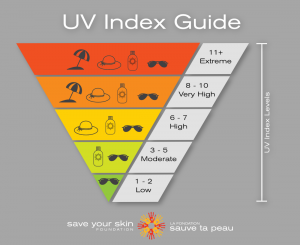Reduce your risk of skin cancer by practicing sun safety all year round. Check your skin regularly and talk to your family doctor or nurse practitioner about any changes to your family’s skin.
How You Can Protect Your Children from Skin Cancer
Skin cancer is the most commonly diagnosed cancer, yet it is also one of the most preventable. 1 in 48 Canadians will be diagnosed with melanoma skin cancer in their lifetime.
Ultraviolet radiation (UVR) is a main cause of skin cancer and about 65% of melanoma cases are due to ultraviolet radiation.
Research shows that childhood exposure to ultraviolet radiation (UVR) from the sun is an important factor to the development of skin cancer later in life. In fact, as few as 1 to 2 blistering sunburns during childhood is linked to increased risk of skin cancer.
Time spent outdoors to play and explore is an important part of child development. Help your child enjoy the outdoors safely by practicing SunSense to protect their skin and develop sun safety habits that will carry on through life.

The UV Index is a useful tool when it
comes to protecting yourself from the sun. It tells you the strength of the sun’s daily UV rays that reach the earth’s surface – the higher the number, the stronger the sun’s rays and the more important it is to protect yourself.
UV Facts:
– UV rays can get through clouds, fog and haze.
– Water, sand, concrete and especially snow reflect the sun’s rays, and make them even stronger.
– We’re exposed to more UV rays as the protective layer of ozone around the earth becomes thinner.
– The main source of UV radiation is the sun, but indoor tanning beds and sun lamps are also sources.
Best Practices for Protecting Skin

- Seek shade – If your shadow is shorter than you, find some shade because this means the sun’s rays are at their strongest.
- Cover Up – Cover as much of your skin as you can with clothing that is made from tightly woven fabric. Or look for clothing that is labelled with a UPF (UV protection factor).
- Wear a hat – Wear a wide-brimmed hat that covers your head, face, ears and neck.
- Wear sunglasses – choose close-fitting ones with UVA and UVB protection in a wraparound style. The label might have UV 400 or 100% UV protection.
- Use sunscreen properly – Apply a broad-spectrum (UVA/UVB protection) sunscreen with SPF 30 or higher. It’s important to apply a generous amount of sunscreen to any skin not covered by clothing and reapply every 2 hours If you’re going in the water, make sure its water resistant and be sure to reapply often. Check out the Sunscreen infographic for more tips about sunscreen application.
Protecting your Baby
- Keep babies out of direct sunlight.
- Use clothing that covers their arms and legs – and don’t forget a hat.
- Keep them protected in a covered stroller, under an umbrella or in the shade. This can also help prevent dehydration and sunstroke.
Is Sunscreen Safe for Babies?
If your baby is less than 6 months old, check with your doctor or nurse practitioner before using sunscreen.
For babies 6 months of age and older, it’s OK to use a small amount of sunscreen on exposed skin (such as their face and the back of their hands). Protective clothing and shade are better protection from the sun, but using a small amount of sunscreen is better than risking a sunburn, which can be serious for a baby. Make sure to test a small amount on your baby’s inner arm to see if the skin reacts to the product before using it on other exposed skin.
To learn more about how you can protect your children please visit BC Cancer’s sunsense.ca.